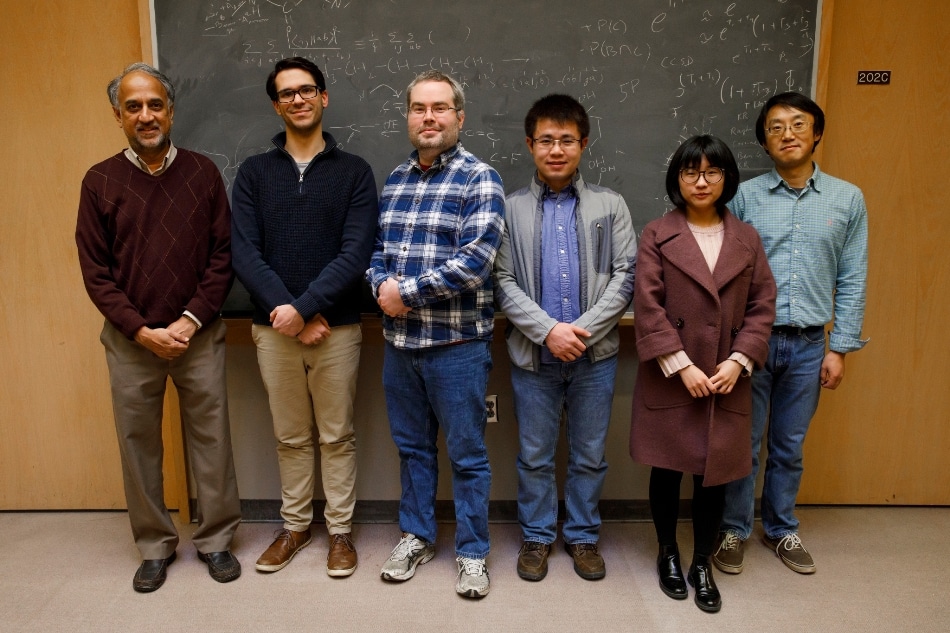Mar 9 2017
 From left, Krishnan Raghavachari, Benjamin W. Noffke, Richard N. Schaugaard, Yijun Liu, Lu Liu and Liang-shi Li. Photo by Indiana University
From left, Krishnan Raghavachari, Benjamin W. Noffke, Richard N. Schaugaard, Yijun Liu, Lu Liu and Liang-shi Li. Photo by Indiana University
An international research team led by Liang-shi Li from Indiana University has reached a new milestone in the quest to create carbon-neutral fuels and others materials from carbon dioxide in the Earth’s atmosphere.
The chemists have developed a molecule that uses electricity or light to efficiently convert the greenhouse gas carbon dioxide into carbon monoxide, a carbon-neutral fuel source, compared to other "carbon reduction" methods.
This process is reported in the Journal of the American Chemical Society.
If you can create an efficient enough molecule for this reaction, it will produce energy that is free and storable in the form of fuels. This study is a major leap in that direction.
Liang-shi Li, Associate Professor, Indiana University
Burning fuel, such as carbon monoxide, generates carbon dioxide and releases energy. It requires the same amount of energy to turn carbon dioxide back into fuel. Reducing the excess energy required for this process has been a major goal among researchers.
This is exactly what the molecule, created by Li, achieves. This molecule requires the smallest amount of energy to drive the carbon monoxide formation. The molecule – a nanographene-rhenium complex connected through an organic compound called bipyridine – causes a highly efficient reaction that turns carbon dioxide into carbon monoxide.
The ability to exclusively and efficiently produce carbon monoxide is significant due to the versatility of the molecule.
Carbon monoxide is an important raw material in a lot of industrial processes. It's also a way to store energy as a carbon-neutral fuel since you’re not putting any more carbon back into the atmosphere than you already removed. You're simply re-releasing the solar power you used to make it.
Liang-shi Li, Associate Professor, Indiana University
Nanographene – a nanometer-scale piece of graphite, a familiar form of carbon (i.e. the black "lead" in pencils) – is the secret to the efficiency of the molecule, because the material’s dark color attracts a large amount of sunlight.
According to Li, bipyridine-metal complexes have been studied for long to reduce carbon dioxide into carbon monoxide using sunlight. However, these molecules can use only a small sliver of the light in sunlight, mainly in the ultraviolet range, which is not visible to the naked eye.
On the contrary, the molecule created at IU takes advantage of the nanographene’s light-absorbing power to produce a reaction that uses sunlight in the wavelength of up to 600 nm – a large part of the visible light spectrum.
Li said that the molecule functions as a two-part system, namely a nanographene "energy collector" that attracts energy from sunlight and an atomic rhenium "engine" that generates carbon monoxide. The energy collector sends a flow of electrons to the rhenium atom, which continually binds and turns the stable carbon dioxide into carbon monoxide.
The idea of connecting nanographene to the metal came from Li's previous attempts to develop more efficient solar cells with the carbon-based material.
We asked ourselves: Could we cut out the middle man -- solar cells -- and use the light-absorbing quality of nanographene alone to drive the reaction?
Liang-shi Li, Associate Professor, Indiana University
Li has plans to make the molecule more powerful, by making it to last for a long time and survive in a non-liquid form, because solid catalysts are very easy to use in the real world. He is also making effort to substitute rhenium atom in the molecule – a rare element – with manganese, a very common and inexpensive metal.
The entire research on the study was performed at IU. The first authors on the paper are Xiaoxiao Qiao and Qiqi Li, former graduate students at IU. Additional authors are professor Krishnan Raghavachari and graduate students Richard N. Schaugaard, Benjamin W. Noffke and Yijun Liu, all of the Department of Chemistry; Dongping Li, a visiting professor from Nanchang University; and Lu Liu, a visiting undergraduate from the University of Science and Technology of China.
This study was supported by IU Office of the Vice Provost for Research and the National Science Foundation.